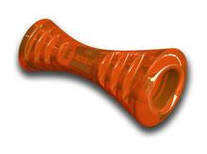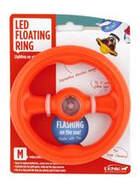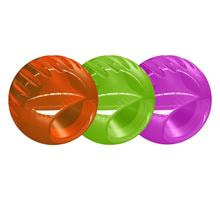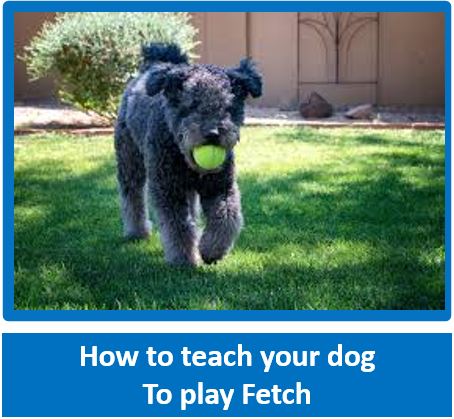Teaching a Pup (or Dog) to Swim
(by Scotty Valadao – Animal Behaviour Consultant (ABC of SA™) : TTouch Practitioner)
Although this article is dedicated to teaching a pup to swim,
the same procedure can be followed for an adult dog.
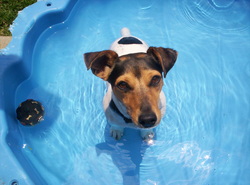
What people don’t realize is that a pup (or a dog) can either get under a pool cover of fall right through it if you have the type with the nylon webbing across the pool. It is far safer to teach your pup to swim.
In addition to this being a safety aspect, the dog can be exercised when you don’t have time to take it out for a walk by having a long swim. In the event of the dog developing hip dysplasia or similar, the dog can be exercised without putting any undue pressure on the joint. Dogs are basically land mammals and the majority of them are not born with the knowledge of how to swim so it will have to be taught. Dogs such as the Portuguese water dog and some retrieving breeds seem to take to water like the proverbial duck to water.
It is best to check with your own vet as to what age they recommend the pup learns to swim as there are many different opinions on this. The most important thing is not to rush this, take it slowly so that the pup gains confidence and does not panic. If you do have access to a stream or river that is shallow enough, where the pup can chase you, run after a ball etc, do try this, it does make the introduction easier. If you have an existing dog that can swim, have the older dog go into the water first. Pups will often follow the lead of an older dog, but be with the pup and help to hold it until it is secure enough to swim by itself.
Contrary to popular believe, not all dogs can learn to swim. It may be that the dog is overweight and breeds such as Bulldogs, Bull Terrier and the French bulldog are well known for swimming ‘like rocks”. We have had three Bull Terriers over the years and despite repeated swimming lessons they never mastered the skill.
Another point owners should bear in mind is to start the pool work when the water and weather is warm. A lot of dogs don’t like cold water and it may not be the swimming they don’t like, but rather the temperature of the water.
Once your pup can swim
Now the fun never ends! Not only can swimming supply good exercise, the fun that dogs have, launching themselves (from the steps of course) in after toys that float that can be retrieved has to be seen to be believed. The pictures below are some of our favourite toys for water fun.
In addition to this being a safety aspect, the dog can be exercised when you don’t have time to take it out for a walk by having a long swim. In the event of the dog developing hip dysplasia or similar, the dog can be exercised without putting any undue pressure on the joint. Dogs are basically land mammals and the majority of them are not born with the knowledge of how to swim so it will have to be taught. Dogs such as the Portuguese water dog and some retrieving breeds seem to take to water like the proverbial duck to water.
It is best to check with your own vet as to what age they recommend the pup learns to swim as there are many different opinions on this. The most important thing is not to rush this, take it slowly so that the pup gains confidence and does not panic. If you do have access to a stream or river that is shallow enough, where the pup can chase you, run after a ball etc, do try this, it does make the introduction easier. If you have an existing dog that can swim, have the older dog go into the water first. Pups will often follow the lead of an older dog, but be with the pup and help to hold it until it is secure enough to swim by itself.
- Before the pup is of the age to start swimming, accustom it to splashing and playing in a child’s paddling pool or one of the plastic shell shaped sandpits. This will ensure that there is less fear when the pool work starts. A word of caution here, if the surface is very slippy, put some non slip rubber material at the bottom to prevent the pup slipping and falling.
- If the pup is going to be of middle or large size, wait till it can stand on the top step before starting the introduction to the pool.
- Get into the pool yourself and have somebody hand the puppy down to you. Let it stand on the step and with your finger on the collar, let it walk back and forward, even playing with a light ball, offering treats and praise. Don’t rush this stage, the more comfortable the puppy is at this state, the easier it will be to get it starting to swim.
- The next step is to step slightly away from the step holding the puppy with your hand under the pelvis and chest. Slowly lower it into the water facing the step (not letting go) keeping the head out of the water and the hindquarters and front legs free so that it can do the ‘doggy paddle’. As it gets its paws onto the firm ground of the step, say ‘step’ and go totally overboard with praise and play a bit at the shallow end Take this very slowly not increasing the distance until the puppy is totally comfortable. Bringing in the cue ‘step’ will get the pup to associate the way out of the pool.
- Practice this as often as possible, gradually building up the distance and staying in the pool yourself to supervise. Realize that if a pup does sink under the water, it will not come up by itself! I myself have brought in a command ‘swim’ whenever I allow Brady in the pool. This has resulted in having a dog that swims mostly on command. On a very hot day he will occasionally go for a dip himself, but it is an exception, rather than a rule.
- In order that the pup retains this new skill, it needs to be practiced as much as possible. When the pup is really proficient and has matured a bit, you can start to have ‘fetch’ games in the pool.
Contrary to popular believe, not all dogs can learn to swim. It may be that the dog is overweight and breeds such as Bulldogs, Bull Terrier and the French bulldog are well known for swimming ‘like rocks”. We have had three Bull Terriers over the years and despite repeated swimming lessons they never mastered the skill.
Another point owners should bear in mind is to start the pool work when the water and weather is warm. A lot of dogs don’t like cold water and it may not be the swimming they don’t like, but rather the temperature of the water.
Once your pup can swim
Now the fun never ends! Not only can swimming supply good exercise, the fun that dogs have, launching themselves (from the steps of course) in after toys that float that can be retrieved has to be seen to be believed. The pictures below are some of our favourite toys for water fun.


